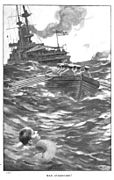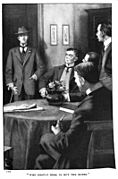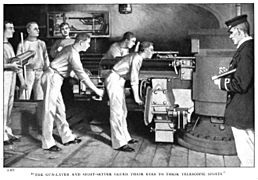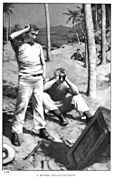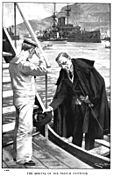Charles Murray Padday facts for kids
Quick facts for kids
Charles Murray Padday
|
|
|---|---|
| Born | 15 January 1868 Notting Hill, London
|
| Died | 10 April 1954 (aged 86) |
| Nationality | British |
| Occupation | Painter and illustrator |
| Years active | 1900-1938 |
| Known for | Paintings of sea themes |
|
Notable work
|
Dividing the Spoil |
Charles Murray Padday (1868–1954) was a famous British artist and illustrator. He was especially known for his amazing paintings of the sea. He was a member of the Royal Institute of Painters in Water Colours and the Royal Institute of Oil Painters.
Contents
Charles Padday's Early Life
Charles Padday was born in London in 1868. His parents were Reginald Salmond Sheriff Padday and Marie Elizabeth Ann. When he was two months old, he was baptised in Notting Hill, London.
Interestingly, different records show different places where he might have been born! Some say Brighton in Sussex, while another record suggests the Straits Settlements (which included places like Singapore and Penang). His father and older siblings were born there. However, the latest records say he was born in London.
Charles went to Hurstpierpoint College school. He was a boarder there, meaning he lived at the school. In 1900, his old school proudly announced that he had two of his paintings shown at the famous Royal Academy of Arts.
Adventures and Family Life
We don't know much about how Charles learned to be an artist. But he had enough money to travel a lot. In 1903, he visited the United States. He arrived at Ellis Island in New York on a ship called the SS Minnetonka. He told officials that he had paid for his own trip and had visited the U.S. before, in 1895.
Later that year, in December 1903, Charles married Rose Blanche Newman (1873-1966). She was from Ireland. At that time, he was living in Bosham, a village in West Sussex. By 1905, he had moved to Itchenor, also in West Sussex, and stayed there for a few years. Around 1910, he moved to Hayling Island.
His first marriage ended. In 1919, he married Bertha Jane Hughes (1875-1959). They lived in Kent for a while, then moved to Folkestone, Kent, around 1928. Charles and Rose had traveled "to nearly every corner of the globe," and he painted scenes from many of the countries they visited.
Padday's Art and Illustrations
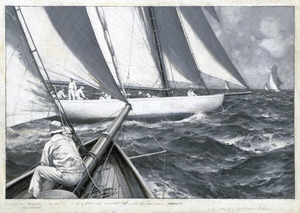
Charles Padday started showing his artwork at the Royal Academy of Arts when he was just 18 years old, in 1886. He continued to show his paintings there for the next 40 years! Only a few times did he not submit a piece. He once said that only one of his paintings was ever turned down, and that was when he was very young. Sometimes, he showed more than one painting. For example, in 1900, he showed two oil paintings: Worsted, which showed a defeated pirate ship, and Cribbage, which was about a card game.
Padday also showed his art at other important places like the Royal Society of British Artists and the Royal Institutes of Painters in Water Colours and Oil Painters. In 1905, he sold a painting called Alone for £300. That was a huge amount of money back then, worth about £37,000 today!
Paintings of the Sea
Padday was especially good at painting marine scenes. This means he painted pictures of the sea, ships, and coastal areas. He painted beautiful views of harbors, including places in the Mediterranean Sea like The Harbour at Bougie, Algeria.
He also loved to paint exciting pirate scenes! Some of his pirate paintings include Loot, A difference, and Dividing the Spoil (painted in 1919). This large oil painting was shown at the Royal Academy and sold for £18,750 in 2018. A newspaper called Morning Post once wrote about his pirate painting Marooned. They said it showed pirates who had been left on an island. The newspaper praised how real the characters looked and how well Padday showed the hot atmosphere of the island.
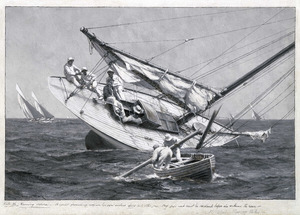
Other sea paintings by Padday include The Pilot Boat Crew (1898), Study of a Clipper at Sea, and Fishing Boats in Harbour. He also painted famous ships like the White Star Line's R.M.S. 'Oceanic'. He was known for his excellent yachting pictures, such as A Yacht Luffing and A Yacht Ashore. A yachting writer for The Field magazine once said that one of his nautical paintings was "well composed and correct in technical detail."
Book Illustrations
Besides his paintings, Charles Padday also drew illustrations for many magazines. These included The Illustrated London News, The Sphere, and The Pall Mall Magazine.
He also illustrated many books! He drew pictures for stories by famous writers like Samuel Taylor Coleridge, Joseph Conrad, and Rudyard Kipling.
During World War I, in 1917, the Navy asked him to paint a special work called Our Safeguard. This painting was meant to be placed in a chapel. Instead, it was hung in the Reading Room of the Trafalgar Institute in Portsmouth. Prints of the painting were sold to help support the institute. Twenty years later, the painting was still there, and they were still selling prints to raise money.
Today, you can see two of Padday's works at the National Maritime Museum. Another one is at the Folkestone Museum.
Book Illustration Examples
Padday illustrated the book John Graham, sub-lieutenant R.N., A tale of the Atlantic fleet (1912) by T.T. Jeans. Here are some examples of his drawings from that book:
When Did Charles Padday Die?
Charles Padday passed away on April 10, 1954, in Sussex. At the time, he was living in Cuckfield, Sussex. His wife, Bertha Jane, was in charge of his estate. She lived for five more years after him, passing away in 1960.


